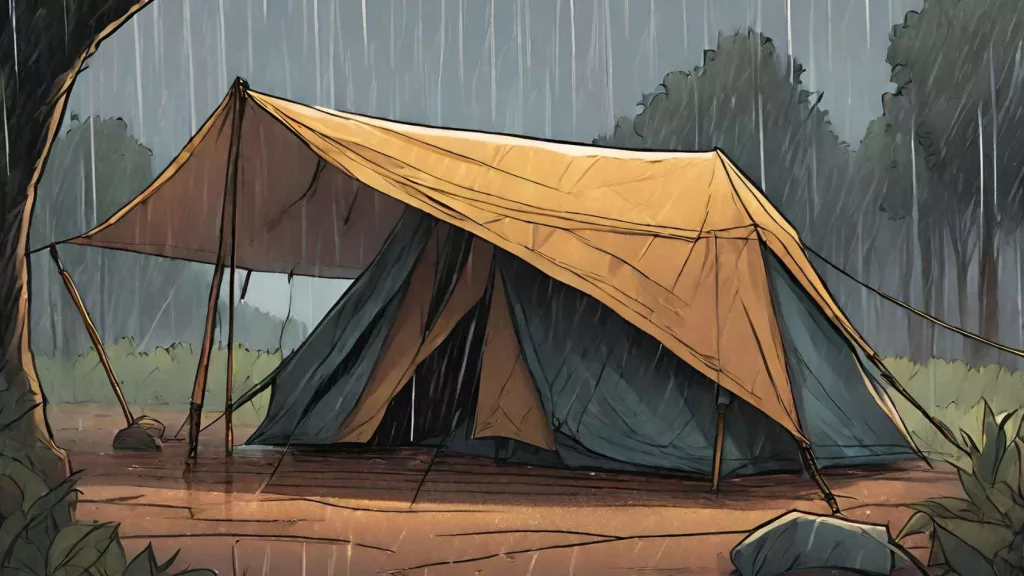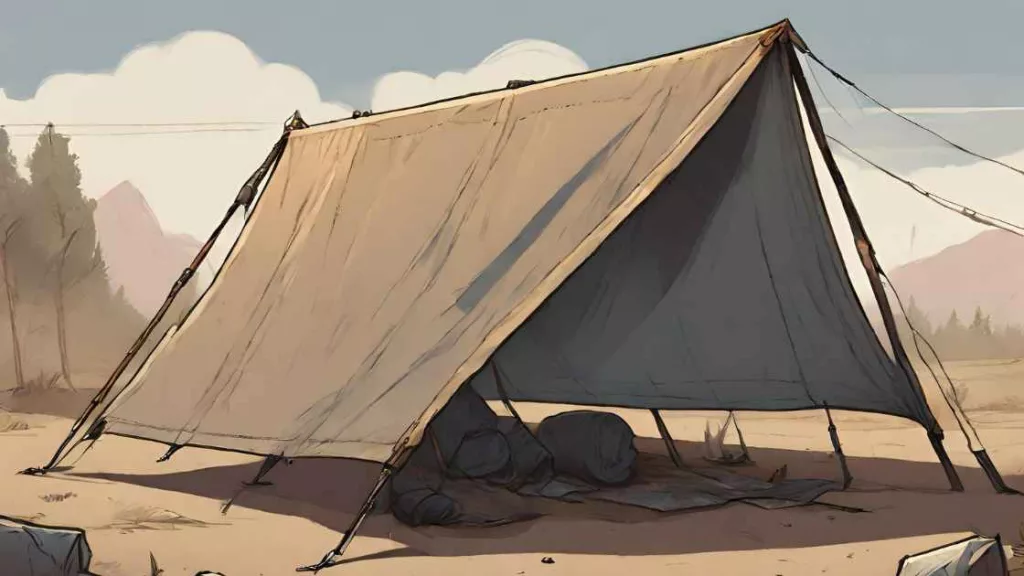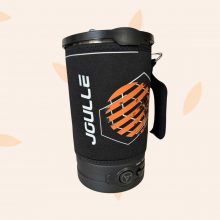Embarking on an adventure into the great outdoors? Choosing the best tarp for camping helps protect your campsite from the elements and adds comfort to your outdoor experience.
For example, a camp tarp can be used as a rainfly or groundsheet footprint to protect your tent against rain and leakage. You can even convert a tarp into a makeshift home under the stars.
There’re tons of tent tarps on the market. In this guide, we’ll tell you everything you need to know to find the right tarpaulin that’ll satisfy all your camping needs.
Why Do You Need A Camping Tarp?
Whether you’re just starting out or you’re a seasoned camper, a reliable tarp is an important tool to have. It prevents water from seeping into your tent from the top and bottom.
If you use the tarp as a rainfly, it can protect you from the elements, while providing additional ventilation for your tent.
Most importantly, a tent tarp provides you with an extra layer of protection that you need in the great outdoors.

How to Choose the Best Tarp for Camping
1. Consider the Different Types of Tarps
There’s a tarpaulin designed for every occasion and camper level. If you’re planning on car camping or setting up a basecamp, you can setup a versatile tarp canopy over a cooking area to shield against rain or sun.
However, if you’re mountaineering or backpacking, then you might need an ultralight tarp that’s easy to carry. On the other hand, if you’re winter camping in the mountains, a heavier, thicker tarp may be best for your needs.
- Vinyl Tarps: Keeps your tent well ventilated with its heat-sealed seams, come fire-retardant and protect you from unfavorable weather conditions. Not to mention, they’re durable and come in a variety of thickness levels.
- Canvas Tarps: Delivers protection from UV Sun rays, with a breathable construction that helps prevent condensation, mildew and moisture buildup. Some styles even come waterproof and are made with extra-thick fabrics that make them perfect for camping outdoors.
- Poly Tarps: These are 100% waterproof and also prevent everything from mildew to rot. Poly Tarps basically take the stress out of tarp camping as they come in several different grades, colors, sizes and weights.
- Mesh Tarp: With its breathable fabric, Mesh Tarps keep you protected and well-ventilated. They offer airflow, sun shade and work well in wind. You won’t have to worry about your tent flying away.
2. Consider the Tarp Size and Shape
You’ll need to consider the configuration, size and dimensions of your tarp. A heavy-duty tarp should always be compatible with your tent size.
- Size: The tarp needs to be large enough to cover your entire tent, with a little extra hanging off the sides.
- Small: 6×8 feet to 8×10 feet – These dimensions are good for creating ground cover for a small tent or serving as a small standalone shelter for one or two people in emergencies.
- Medium: 10×10 feet to 12×12 feet – Good for ground cover under medium-size tents and small stand-alone group shelters.
- Large: 12×16 feet to 16×20 feet – Ideal for large tents, group shelters, creating expansive cover for cooking areas, or even protecting multiple tents.

- Shape: Choose whether you need a square or rectangular tarp, depending on how you plan to use the tarp.
- Square Tarp: This shape is ideal to create a basic shelter or rainfly. Set it up diagonally between trees or using trekking poles for a simple A-frame shelter. You can also use this tarp shape as simple footprint ground cover beneath your tent.
- Rectangular Tarp: This tarp shape is optimal for shelters like the classic “plow point” or “flying diamond” setup and might give your campsite more cover and stability in wind. For solo camping, a smaller rectangular tarp may also be easier to set up.
3. Consider the Best Material for a Tarp Shelter
The best camp tarp material depends on things like durability, weight, waterproofing, expected weather and how you’re planning to use it. Here are some common materials used for tarps and their qualities:
- Polyethylene: Most commonly used as a tent footprint, these tarps are affordable, waterproof, and widely available. However, they might be heavier and less durable than other materials.
- Silnylon (Silicone-Coated Nylon): Also used as a footprint or makeshift rainfly, Silnylon is lightweight, waterproof, and packs down small, making it great for backpacking. It’s durable but can be prone to tearing if not handled carefully.
- Canvas: Canvas tarps are durable, breathable, and resistant to UV damage. They’re heavier than nylon tarps but very robust and often used for long-term or semi-permanent shelters.
- Ripstop Nylon: This material has reinforced squares to prevent tears from spreading. It’s lightweight, durable, and ideal for backpacking or situations where weight matters.
- PVC (Polyvinyl Chloride): PVC tarps are heavy-duty and extremely waterproof but less breathable. They’re commonly used for more industrial or heavy-duty purposes.
- Tyvek: Tyvek is a synthetic material that’s lightweight, water-resistant, and durable. It’s often used as a groundsheet or footprint due to its tear-resistant properties.
Also, make sure to look at the company reviews and the brand name for success rates. That way, you’ll know if that business offers good quality groundsheet tarps or not.
4. Consider the Accessories Needed for Tarp Camping
Double check that your tent tarps come with the right tools you need to set it up, like poles, clamps, and guy lines. Typically, the tarp should come with stakes and ropes for securement purposes. It doesn’t hurt to buy a few spare parts, either. You never know when you might need a spare stake for an emergency situation.
Here’s a full list of accessories that can improve the functionality and usability of a camping tarp:
- Tarp Poles: Adjustable or telescoping poles are handy for creating a standalone shelter if trees or other anchor points aren’t available. They allow you to set up the tarp in various configurations.
- Guy Lines and Tensioners: These help secure the tarp and provide stability in windy conditions. They allow you to adjust the tension easily, keeping the tarp taut and secure.
- Tarp Clips or Clamps: These accessories can be used to attach the tarp to lines, cords, or other gear, providing additional securing options without causing damage to the tarp.
- Ground Stakes: Good quality stakes are essential for anchoring the tarp to the ground. Look for sturdy ones that can handle different types of terrain.
- Repair Kit: Carry a small repair kit with patch material and adhesive specifically designed for repairing tarps. This can be crucial if the tarp gets damaged during use.
- Storage Bag or Stuff Sack: Keeping the tarp in a dedicated bag helps with organization and protection when not in use. It also makes it easier to carry along with other camping gear.
- Grommets or Tie-Out Points: Depending on the tarp, you might want to reinforce or add additional tie-out points for more versatility in pitching options.
- Tarp Liner or Footprint: A ground cloth or footprint specifically sized for your tarp can protect the underside from abrasion, moisture, or damage caused by sharp objects on the ground.
- Cordage or Paracord: Extra rope or cordage is always useful for securing the tarp, creating additional guy lines, or improvising in various situations.

What are the Benefits of Camping with a Tarp?
- Lower Cost: Tarps are more affordable than a footprint and a standalone tent. For example, a footprint can cost $50 or more, while a tarp can be purchased for much less. However, if you’re planning on replacing your tent with a tarp, make sure you’re buying a good quality tarp over a cheap one. Nor should you trade in a cheap one for a tent and risk facing Mother Nature’s wrath.
- Nature Views: Even better, tarp camping will allow you to experience all the wonders nature has to offer. A tent tarp may protect you from the natural elements but it can also let you watch the Northern Lights at night. How cool of an experience is that?
- Extra Weather Protection: A Tarp paired with a tent is great at protecting you from a hail storm and providing you extra shaded space. Having a lot of dry space is especially crucial for when you bring the whole family along camping.
- Extra Waterproof Protection: A tent tarp provides you with an extra level of protection from the rain, especially when used as a footprint for your tent. You won’t have to worry about water slipping right through into your tent or moisture buildup. Your tent will stay nice and dry during the whole trip.
- Variety of Setup Options: If you’re new to camping, you might want to practice your camping setup a few times in the backyard before your big trip. Even the experienced camper could brush up on his or her setup skills, too. There’re several different ways to set up your tarp tent for camp, but it all comes down to what works best for you.
What Features are Important for a Camping Tarp?
When choosing your camping tarp, prioritize durability, functionality, and ease of use.
- Materials: Opt for fabrics made from polyester or ripstop nylon
- Size: Choose a tarp size that fits your shelter without being too large
- Weather Resistance: Prioritize weather resistance, seek tarps treated for water repellency or equipped with coatings for added protection against the elements.
- Accessories: Look for reinforced corners and attachment points for secure anchoring and versatility in setting up your shelter configuration.
- Multi-Functionality: Assess the tarp’s multi-functionality. A tarp that can be used as a ground cover, rain shelter, sunshade, or windbreak adds value and enhances the camping experience by providing protection and versatility in different terrains and weather.
What are the Best Tarps for Camping in Wet Weather?
When choosing a wet weather camping tarp, it’s important to think about things like how waterproof it is, how big it is, and how strong it is. This will help you make sure that the tarp is right for the kind of camping you’re doing.
Snow Peak Takibi Hexa: This tarp is perfect for a variety of camping needs, including providing reliable protection in wet conditions.
Unigear Tent Tarp: Considered the top choice for a camping tarp that provides excellent value. This option is affordable, yet still delivers high quality and performance. It is a great option for wet weather conditions.
Amazon Basics Waterproof Tarp: This tarp is a top choice for under-tent use. It is designed to be waterproof, making it great for camping in wet conditions.
Kelty Waypoint Car Tarp: This tarp is designed specifically for car camping and can effectively protect against rain, offering a reliable shelter choice.
MSR Rendezvous Sun Shield 200 Wing Shelter: This is the top-rated sun shelter tarp that can also protect you from rain and wet conditions. It is a versatile choice for different weather conditions.
How to Choose the Best Tarp for Under a Tent
- Material: Look for durable materials like polyethylene, coated nylon, Tyvek, or silnylon. These materials offer varying degrees of water resistance, durability, and weight.
- Size: The tarp should be slightly smaller than the base of your tent to prevent water from pooling between the tarp and the tent floor. However, it should still adequately cover the area under your tent.
- Weight and Packability: If you’re backpacking or hiking, consider the weight and packability of the tarp. Lighter materials like silnylon or Tyvek can be advantageous for reducing pack weight.
- Grommets or Attachment Points: Some tarps have grommets or attachment points that allow you to stake them down securely. This helps prevent the tarp from shifting or blowing away in windy conditions.
- Rip Resistance: Choose a tarp that can withstand ground abrasion to protect your tent floor from damage over time.
What are the Differences Between Vinyl-Coated Polyester Tarps and Iron Horse Polyester Tarps?
Vinyl-coated polyester tarps are strong, sturdy, and great for heavy-duty use, like protecting construction or machinery. Iron horse polyester tarps are breathable, waterproof, and best suited for everyday outdoor recreation, like shade canopies.
Vinyl-Coated Polyester Tarps:
- Made from strong and durable vinyl-coated polyester (PVC) material that can resist water, mildew, and UV rays.
- Often used in tough environments like construction sites, transportation, and industrial settings.
- Heavier than canvas and poly tarps, and best used in situations where weight and size don’t matter, like covering heavy machinery or hauling on a flatbed truck.
- Pricier than poly tarps because they are made with better materials and are more durable.
Iron Horse Polyester Tarps:
- Made from a tough polyester fabric that is treated with silicone to be breathable, waterproof, and strong.
- Last for a long time and are stronger than canvas tarps, but can rip if not taken care of properly.
- Ideal for uses like awnings, canopies, shade structures, boat covers, truck covers, and outdoor furniture covers.
- Comes in different colors and is odorless.
What are the Differences Between Silnylon, Cuben Fiber, Poly, and Tyvek Tarps for Under a Tent?
Silnylon is affordable with good tear resistance, but requires maintenance. Cuben Fiber is strong and waterproof, but more expensive. Poly (Silpoly/Silpoly) offers a balance of price, water repellency, and UV resistance. Tyvek is a lightweight, durable, and waterproof option for DIY tarps.
Silnylon:
- Made of nylon coated with silicone, which makes it waterproof and durable.
- Pros: Affordable, tear-resistant, compact, available in various colors.
- Cons: Vulnerable to UV rays, can absorb water, requires re-tensioning when wet, seams need to be sealed.
Cuben Fiber:
- Made with Dyneema fiber, which makes it very strong against tearing and waterproof.
- Pros: Very tear-resistant, waterproof, lightweight, does not absorb water.
- Cons: Expensive, not as compact as silnylon, stiffness, needs to be set up precisely.
Poly (Silpoly/Silpoly):
- Polyester coated with silicone, which makes it water repellent and resistant to UV rays.
- Pros: Affordable, maintains tension when wet, offers good UV resistance, compact.
- Cons: Less tear-resistant than silnylon, limited material options, seams need to be sealed.
Tyvek:
- Material that is light, allows air to pass through, lasts long, and keeps water out. Often used for DIY tarps.
- Pros: Light, breathable, very durable, waterproof.
- Cons: Can make noise, limited colors, might need to seal seams.
Camp Tarp FAQs
What kind of tarp is good for camping?
Look for a tarp made of heavy-duty, waterproof material, with reinforced grommets for easy tie-downs. You want it to be big enough to cover your entire campsite, so the tarp can be used as a rainfly or footprint, but not so big that it’s a pain to pack up. The last thing you want is to be wrestling with a monstrous tarp in the middle of a windstorm.
What is the best tarp for under a tent?
A flat tarp made of polyethylene or silnylon are the most common materials to keep the ground dry under a tent. Silnylon, Dyneema or Tyvek also work well because of their lighter weight, and are popular choices for backpacking trips.
How big should a tarp be for camping?
The size for a camping tarp depends on the number of people, intended use, and size of your shelter. In general, a tarp size for one or two people ranges between 6×8 feet to 10×10 feet, a medium tarp size for three to four people ranges between 10×10 feet to 12×12 feet and a large tarp size for 6+ people ranges between 12×16 feet or more. The tarp needs to be large enough to provide shelter, gear protection, shade, and flexibility in different weather without being overly bulky.
What is the best material for a tarp shelter?
The best tarp material depends on weight, durability, and the tarp’s purpose.Nylon variants like silnylon or ripstop nylon offer a good balance between weight and water resistance, making nylon ideal for backpacking or lightweight setups. On the other hand, canvas proves robust and breathable, suited for longer stays or semi-permanent shelters. Polyethylene remains a cost-effective option with decent waterproofing, while PVC delivers heavy-duty waterproofing but sacrifices breathability.
How thick should a tarp be for camping?
The thickness of a camping tarp is measured in mil or gauge. For general camping purposes, a tarp between 5 to 10 mil (or equivalent in gauge) thickness often strikes a good balance. Thinner tarps offer ultralight weight and are easy to carry, but might also be less durable. Thicker tarps, like a rain tarp for emergency shelter give you more protection and strength, but are heavier and more bulky.
What should I look for in a camping tarp?
Durability, size, and versatility are important features to look for in a camping tarp. Choose a sturdy material like ripstop nylon or polyethylene for resistance against wear and tear. Aim for a size that will cover your shelter area without being difficult to carry—10×10 feet to 12×12 feet is usually the easiest. Look for reinforced edges and attachment points for secure setup, and consider the tarp’s weight and packability for ease of transport during your camping excursions.
Are square or rectangular tarps better for camping?
The choice between square or rectangular tarps for camping hinges on desired coverage area, pitching flexibility, and ease of setup. Rectangular tarps often offer more pitching options and varied setups for shelters or ground cover, while square tarps can be simpler to set up.
Which is better polypropylene or polyethylene tarp?
There’s no one-size-fits all answer to this question, and the choice between polypropylene or polyethylene depends on your needs. Polypropylene Tarps provide better UV protection and mold-resistance, while Polyethylene Tarps are more durable and rip-proof.
Final Thoughts: Tarp Camping Done Right
Whatever your camping needs may be, make sure you choose the best camping tarp for you. Buying a Vinyl or even a Mesh Tarp shows you’ve considered all the scenarios and are well prepared. Venturing into the great wilderness can be fun, but only if you have all the right tools on hand.






